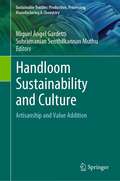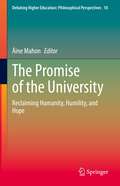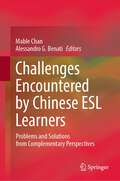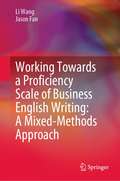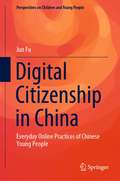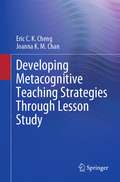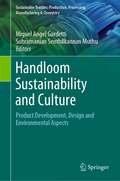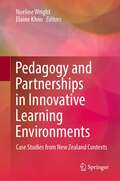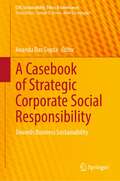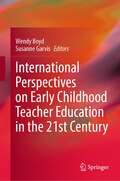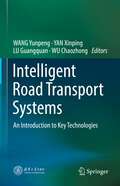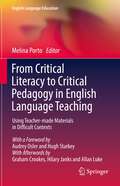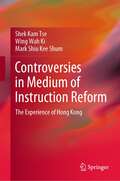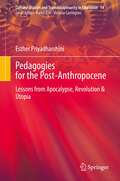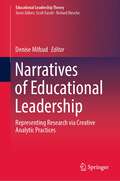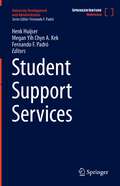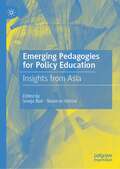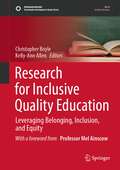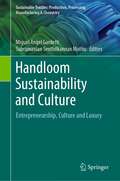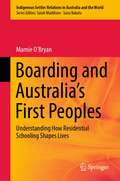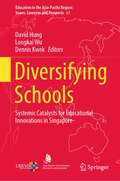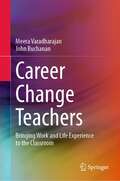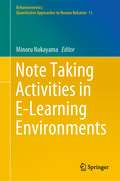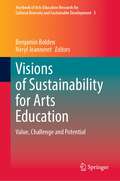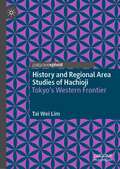- Table View
- List View
Handloom Sustainability and Culture: Artisanship and Value Addition (Sustainable Textiles: Production, Processing, Manufacturing & Chemistry)
by Miguel Ángel Gardetti Subramanian Senthilkannan MuthuThis book contains seven chapters written by leading experts in the areas and discusses means to revive some of the cultures that are on the verge of closing/shutting down. This second of the three book series highlights the intricate relationship in the handloom industry between its culture and the various areas of sustainability. While there have been major disruptions in this age old industry, this book presents the craftsmanship/artisanship and its value addition to keep the industry moving ahead.
The Promise of the University: Reclaiming Humanity, Humility, and Hope (Debating Higher Education: Philosophical Perspectives #10)
by Áine MahonThis book offers philosophical readings of the contemporary university and is motivated by a series of pressing challenges in the global context of Higher Education. It argues that the university is a place for community, for refuge, for enlightenment and the careful questioning of knowledge, but it is also a place for visceral ambition and for intellectual cowardice, for blinkered individualism and professional competitiveness. In the context of a highly competitive post-crash global economy, contemporary students are placed under increasing pressure to distinguish themselves from their peers via a portfolio of learning excellence and extracurricular achievement. Growing numbers undertake part or full-time employment in order to cover registration fees and the basic costs of living. University staff take on very different forms of pressure that operate across the life-course of an academic career – from early-career anxieties to the worries of more privileged and permanent faculty who fear they do not meet ever-changing structures, assumptions and demands of the university itself. This book argues that these interlinked agendas demand consideration from philosophers of education in Ireland, Europe and further afield. It proposes that we must embody a very careful balancing act: one where we remember the romantic ideals and promises of the university while still acknowledging the very real and pressing challenges faced by our staff and students. The book will be of interest to academics, graduate students, and advanced-level undergraduates in Philosophy, Education, Mental Health, and Organizational Psychology in both North America and Europe.
Challenges Encountered by Chinese ESL Learners: Problems and Solutions from Complementary Perspectives
by Mable Chan Alessandro G. BenatiThis book provides a blended approach in outlining the properties of grammatical knowledge that have been causing difficulty to Chinese speaking learners, including tense and aspect, articles, passives, unaccusatives, plurality and motion verbs. It explains from different linguistics perspectives how these constraints/difficulties might be dealt with. It also offers readers a comprehensive account of these problems, and outlines the possible pedagogical solutions teachers can try in the classroom. These topics are selected because they bring substantial challenges and difficulties to Chinese English as a Second Language (ESL) learners. This book bridges the gap between acquisition theory and language pedagogy research, benefiting not just language learners but language teachers around the world, and all those who would like to witness collaboration between second language acquisition theory and second language teaching practice in general. It initiates future work in which researchers from different fields with diverging theoretical perspectives and methodological approaches will be able to develop studies that are compatible with each other. This overall can facilitate our understanding of second language acquisition, and how instruction might help.
Working Towards a Proficiency Scale of Business English Writing: A Mixed-Methods Approach
by Li Wang Jason FanThis book presents an empirical study to develop and validate a proficiency scale of business English writing in the Chinese tertiary context. Through a mixture of intuitive, quantitative and qualitative methods, the book demonstrates how a pool of descriptors are collectively formulated, statistically calibrated and meticulously validated for the establishment of a proficiency scale of business English writing. The writing scale differs in significant ways from the existing language scales, most of which were constructed in English as L1 or L2 contexts and applied to English for General Purposes (EGP) domains. This book also provides important insights into the construct of business English writing as well as the methods for English for Specific Purposes (ESP) proficiency scale development and validation. It is of particular interest to those who work in the area of ESP teaching and assessment.
Digital Citizenship in China: Everyday Online Practices of Chinese Young People (Perspectives on Children and Young People #12)
by Jun FuThis book examines how emerging forms of citizenship are shaped by young people in digital spaces as way of making sense of contemporary Chinese society, forming new identities, and negotiating social and political participation. By focusing on Chinese young adults' everyday online practices, the book offers a unique treatment of the topic of young people and the Chinese Internet that navigates between the dominant focus on censorship on the one hand and protest and politicized action on the other. The book brings the focus of research from highly visible or spectacular forms of collectivity, belonging, and identification exhibited in young people's online practices to young people's everyday social and cultural engagement through new media. It brings new insights by understanding the meanings of young people's mundane and everyday online engagement for their citizenship learning, identity performance, and their formation of political subjectivity. Readers will gain insights into citizenship in China, and young people and the Chinese Internet.
Developing Metacognitive Teaching Strategies Through Lesson Study
by Eric C. Cheng Joanna K. ChanThe book illustrates how Lesson Study can be applied to craft metacognitive teaching strategies to enhance students’ learning to learn competencies. Based on the findings of an empirical study of a university-funded teaching development project, this book reports how to apply Lesson Study and Learning Study to enhance teachers’ metacognitive teaching competencies with a view to tackling the impacts and challenges created by and underlying the learning to learn curriculum. The book allows readers to experience metacognitive learning by sorting the prior knowledge on the metacognition, setting the goal and planning reading schedule, checking their understanding and progress, evaluating what they have or have not learned and reflected on their reading experience and feelings. Readers can grasp the key concept underpinning metacognitive teaching, including teaching strategies for developing students’ metacognitive abilities that include working on problem-solving activities, working on small collaborative groups, making metacognitive and learning strategies explicit, and encouraging students to reflect upon and talk about their learning.
Handloom Sustainability and Culture: Product Development, Design and Environmental Aspects (Sustainable Textiles: Production, Processing, Manufacturing & Chemistry)
by Miguel Ángel Gardetti Subramanian Senthilkannan MuthuThis third of the three volume series highlights the intricate relationship in the handloom industry between its culture and the various areas of sustainability. While there have been major disruptions in this age old industry, this volume presents the design, development and environmental aspects to keep the industry moving ahead. The book contains seven chapters written by leading experts in the areas and discusses means to revive some of the cultures that are on the verge of closing/shutting down.
Pedagogy and Partnerships in Innovative Learning Environments: Case Studies from New Zealand Contexts
by Noeline Wright Elaine KhooThis book examines contexts and possibilities in Aotearoa New Zealand education contexts arising from the international trend for open, flexible, innovative learning environments (ILE), specifically on the pedagogical load. The book responds to questions such as: What does it mean to teach, learn or lead in an innovative learning environment? What happens when teachers move form single cell learning spaces to open, collaborative ones?The chapters provide examples of how teaching in new spaces can be an exciting challenge for teachers and students where they try new ways of teaching and learning, and rethink the purposes of learning and the implications of societal change for learning and what is valued. Examples are drawn from pre-service teachers working in primary and secondary schools and in-service teachers learning to become professionals.The book offers insights into a variety of educational contexts where teachers and students learn and adapt to new learning spaces, and also how different teaching and learning partnerships may be conceived, and flourish. It focuses attention on a range of aspects that teachers, school leaders, and other educators, and researchers may find valuable when they embark on similar initiatives to consider issues pivotal to productive and effective innovative learning environment design, development and implementation.
A Casebook of Strategic Corporate Social Responsibility: Towards Business Sustainability (CSR, Sustainability, Ethics & Governance)
by Ananda Das GuptaThis casebook argues that corporate sustainability agendas should look beyond stakeholder demands and desires, towards strategic opportunities to achieve social and commercial benefits simultaneously. It encourages shifting focus from a strategic approach to a sustainable business practice. As the cases in the book highlight, it is in every company’s best interest to identify a manageable number of sustainability initiatives whose shared benefits—for society at large and the company—are significant and also substantially help the company strategically position itself in the competitive marketplace. Strategic sustainable business practices can lead to shared value creation, strengthening the company’s competitiveness and establishing a symbiotic relationship. Companies can achieve solid profits by doing good things for the environment; it is a “win-win” for society and for business. This casebook provides examples of multi-stakeholder partnerships that aim to create sustainable enterprises. Ideal for teaching purposes, after a brief introduction to the case method, the cases are presented with no comments or criticisms.
International Perspectives on Early Childhood Teacher Education in the 21st Century
by Wendy Boyd Susanne GarvisThis book provides significant information regarding the policies and provisions for early childhood teacher education programs in universities in fourteen different countries. Early childhood education and care (ECEC) is expanding rapidly across the globe with unprecedented numbers of children attending EC centres, requiring the investment in educators to provide good quality ECEC. Yet, there is an inconsistent approach to early childhood teacher preparation and the quality of existing programs is not known.Each country’s contributing author/s is/are well known in their field for their in-depth knowledge of early childhood teacher education programs including content, structure, and professional experience that works within the scope of policy and registration agencies. The chapters address the current situation of staffing—shortage or oversupply—of early childhood teachers in their country. The book informs policy regarding content of early childhood teacher preparation programs and provides evidence of current courses across many under-represented countries throughout the world. It makes a significant contribution to understanding the environment for early childhood teacher programs.
Intelligent Road Transport Systems: An Introduction to Key Technologies
by Wang Yunpeng Yan Xinping Lu Guangquan Wu ChaozhongIn recent years, the application of intelligent transportation systems (ITS) has steadily expanded, and has become a hot spot of common interest to universities, scientific research institutes, enterprises and institutions in the transportation field. ITS is the product of the deep integration of modern high-tech in the transportation industry, and its development has accompanied that of modern high-tech. ITS is now also becoming part of the Internet of Things (IoT), and is expected to contribute significantly to making our cities smarter and connecting with other infrastructure. Although there are many monographs and textbooks on intelligent transportation, with the advancement of technology and changes in demand, the key technologies of ITS are also rapidly changing.This book chiefly focuses on the main technologies of ITS, examining them from four perspectives: “sense” (perception and management of traffic information, chapters 2 & 3), “transmission” (interaction of traffic information, chapter 4), “prediction” (prediction of traffic states, chapter 6) and “application” (intelligent transportation applications, chapters 6 through 10). Given its scope, the book can be used as a textbook for undergraduates or graduates, as well as a reference book for research institutes and enterprises.This book emphasizes the use of basis traffic engineering principles and state-of-art methodologies to develop functional designs. It largely reflects the authors’ own experience in adapting these methodologies to ITS design. For example, the book addresses various forms of data collection, models used to predict and evaluate traffic states, comprehensive description in connected vehicles, applications for users and traffic managers, etc. The knowledge gained here will allow designers to estimate the performance differences among alternatives and gauge their potential benefits for functional design purposes. To gain the most from the book, readers should be somewhat familiar with the field of traffic engineering and interested in ITS.
From Critical Literacy to Critical Pedagogy in English Language Teaching: Using Teacher-made Materials in Difficult Contexts (English Language Education #23)
by Melina PortoWith a Foreword by Hugh Starkey and Audrey Osler, and Afterwords by Graham Crookes, Hilary Janks and Allan Luke, this book promotes critical language education and illustrates how a critical agenda can be enacted in English language education in real classrooms. It presents four cases located in primary and secondary schools in the province of Buenos Aires in Argentina in contexts that can be characterised as vulnerable or difficult. It describes the possibilities, challenges and limitations of this critical agenda using students’ drawings, posters, leaflets, artwork, classroom activities and conversational data as foundation, and including the voices of local teachers in their classrooms. Importantly, these teachers used teacher-made, locally produced, critical post-method materials, described by the author of those materials in one of the chapters. In this way, the book offers a unique balance of researcher, teacher and materials writer voices. These materials are included in the book and can help language teachers around the world to introduce critical perspectives in their specific contexts. The book is appealing to researchers, classroom teachers, teacher educators, and materials writers and developers interested in critical language education.
Controversies in Medium of Instruction Reform: The Experience of Hong Kong
by Shek Kam Tse Wing Wah Ki Mark Shiu ShumThe book is an in-depth and comprehensive analysis of the case of language in education reform and language policy controversies of Hong Kong over the initial two decades after 1997. It is a scholarly monograph of conscientious educators and researchers who have been active during the education reform, collaborating with different parties on school development and classroom teaching experiments. This book provides a multiple-perspective investigation into the education and language matters. Besides socio-political perspectives, this book also emphasizes the frontline educational and practical perspectives. The book explores the benefits and effective methods of mother-tongue and multi-lingual teaching that have emerged in the period. Based on the problematic experience of language purism and bifurcation in the reform, the book argues for an inclusive multilingual education policy with mother-tongue as the core. This book provides potential solutions and good practices to tackle the complex issues brought about by medium of instruction policy reforms in post-colonial times.
Pedagogies for the Post-Anthropocene: Lessons from Apocalypse, Revolution & Utopia (Cultural Studies and Transdisciplinarity in Education #14)
by Esther PriyadharshiniThis book draws on posthumanist critique and post qualitative approaches to research to examine the pedagogies offered by imaginaries of the future. Starting with the question of how education can be a process for imagining and desiring better futures that can shorten the Anthropocene, it speaks to concerns that are relevant to the fields of education, youth and futures studies. This book explores lessons from the imaginaries of apocalypse, revolution and utopia, drawing on research from youth(ful) perspectives in a context when the narrative of ‘youth despair’ about the future is becoming persistent. It investigates how the imaginary of 'Apocalypse' acts as a frame of intelligibility, a way of making sense of the monstrosities of the present and also instigates desires to act in different ways. Studying the School Climate Strikes of 2019 as 'Revolution' moves us away from the teleologies of capitalist consumption and endless growth to newer aesthetics. The strikes function as a public pedagogy that creates new publics that include life beyond the human. Finally, the book explores how the Utopias of Afrofuturist fiction provides us with a kind of 'investable' utopia because the starting point is in racial, economic and ecological injustice. If the Apocalypse teaches us to recognize what needs to go, and Revolution accepts that living with ‘less than’ is necessary, then this kind of Utopia shows us how becoming ‘more than’ human may be the future.
Narratives of Educational Leadership: Representing Research via Creative Analytic Practices (Educational Leadership Theory)
by Denise MifsudThis book documents and deconstructs the concept of educational leadership within various education settings originating from diverse global environments. It focuses on presenting different readings of educational leadership via distinct theoretical and methodological applications. It takes forward the idea of critical leadership studies and uses creative analytic practices to present layered readings of educational leadership.The book offers leadership studies dealing with various education settings across a wide spectrum with international perspectives. It provides examples of educational narratives through somewhat unconventional modes of representation. This book is beneficial to readers interested in the study of educational leadership and using qualitative methodologies in educational research.
Student Support Services (University Development and Administration)
by Henk Huijser Megan Yih Chyn A. Kek Fernando F. PadróThis volume Student Support Services: Exploring impact on student engagement, experience and learning, covers a wide and diverse range of higher education contexts to explore the current state and the future of student support services. The central focus for all the chapters is about what, why and how to achieve student success within an intricate and complex web of learning ecologies, often invisible to the naked eye but interconnected within and between each other. This has profound impacts on students, often characterised by an ongoing tension between students as learners and students as consumers. With over 40 chapters, the book is divided into two sections. Part 1 is a conceptual section, which explores a multitude of worldviews about the ways in which student support services have impacted and may impact on student engagement, experience and learning. This includes discussions about the tensions and opportunities that arise from the curricular, co-curricular, and extra-curricular conceptualisations of students support services. The discussions come from the vantage point of different ecologies within and between universities and student support services’ impacts, both intentional and accidental, on the development of students, their transformation as learners and as contributing members of the workforce. For example, this covers disruptive technologies and online approaches, university mission and purpose, worldviews and paradigms held by student support and services units, motivation, student retention, and sense of belonging. Part 2 is a practice-based section with reflections and case studies, again from a wide variety of different higher education contexts. This section dives into the how – approaches, solutions, processes – deployed by universities to respond to their identified and often contextualised student support and services challenges. This section provides a rich library of possible ideas that readers can reimagine to manage and/or solve their student support and services challenges and problems. In the context of widening participation agendas and an increasingly demand-driven higher education sector, combined with ever-tighter public funding streams and turbulent socio-political environments, the higher education sector has had to step up its game in attracting students and diversify its approaches and strategies. As part of recruitment strategies and marketing campaigns, it has become common to approach potential students as ‘customers’. Transaction as a form of two-way (beneficial) engagement has given way to transaction as an exchange for a service or a good focused on order, structure and risk aversion. This book explores whether this is a productive way of approaching it. At the same time, the impact of COVID-19 has drawn further attention to the challenges of creating a sense of community, sense of belonging, personal identity and engagement within the university environment, especially for those not habitually and constantly on-campus. The difficulty of commuter students more fully engaging with university curricular and co-curricular programs remains, especially as students have to spend more of their time working to meet direct and indirect costs of partaking in university studies. Thus, student identity, in terms of being (or becoming) an integral member of the university community, and co-and extra-curricular engagement that enhances the learning of online students are increasingly important areas for universities to pay attention to, and this book shows different pathways – both worldviews and practices - in that respect. In an increasingly complex higher education environment, student support services find themselves in an interesting, yet often contradictory, position of having to provide a ‘customer service’ while also 'developing students’ throughout their learning journeys within the university, and their future readiness beyond the university, which is increasingly pertinent in a supercomplex world of diversity, contradictions and uncertainties. This volume
Emerging Pedagogies for Policy Education: Insights from Asia
by Sreeja Nair Navarun VarmaThis edited book captures key trends that are driving changes in policy education and presents a repertoire of pedagogies to prepare educators and policy programme designers to teach for better impact in learning and policy practice. Supported with observations from selected Asian universities the chapters cover the experiences of authors in working with students at undergraduate and postgraduate levels, as well as professional programmes such as executive education, training, and capacity building for mid-career professionals and practitioners. Part I of this book presents ideas that are asserting the need for incorporation of new content as well as teaching practices for policy education. Part II covers selected cases of application of pedagogical approaches and strategies in Asian universities, tested at different education levels, modes of teaching, and disciplines.
Research for Inclusive Quality Education: Leveraging Belonging, Inclusion, and Equity (Sustainable Development Goals Series)
by Christopher Boyle Kelly-Ann AllenThis book explores contemporary perspectives and research on inclusion, providing a platform for discussing inclusion at an international level and its intersections with belonging and equity. How inclusion is defined and applied between schools, districts, and even countries can vary markedly; thus, an international understanding of inclusion is urgently needed. Experts from several countries in different regions present the latest research in the field of inclusion and provide practices and strategies guided by empirical research to address some of these issues. Schools are contextual organisations that represent the broader society, culture, and values in which they reside. Thus, how inclusion is practised at the society level has an implication on schools. The way we think about inclusion has shifted dramatically in the last decade - we now recognise that inclusion represents a broad spectrum of racial, ethnic, cultural, and sexual diversity that is seen in almost all modern schools. This book presents international perspectives and research on inclusion, belonging and equity to work towards a more consistent, collaborative, and global understanding.
Handloom Sustainability and Culture: Entrepreneurship, Culture and Luxury (Sustainable Textiles: Production, Processing, Manufacturing & Chemistry)
by Subramanian Senthilkannan Muthu Miguel Ángel GardettiThis first of the three volume series highlights the intricate relationship in the handloom industry between its culture and the various areas of sustainability. While there have been major disruptions in this age old industry, this volume presents the luxury and the entrepreneurship aspects to keep the industry moving ahead. The book contains seventeen chapters written by leading experts in the areas and discusses means to revive some of the cultures that are on the verge of closing/shutting down.
Boarding and Australia's First Peoples: Understanding How Residential Schooling Shapes Lives (Indigenous-Settler Relations in Australia and the World #3)
by Marnie O’BryanThis book takes us inside the complex lived experience of being a First Nations student in predominantly non-Indigenous schools in Australia. Built around the first-hand narratives of Aboriginal and Torres Strait Islander alumni from across the nation, scholarly analysis is layered with personal accounts and reflections. The result is a wide ranging and longitudinal exploration of the enduring impact of years spent boarding which challenges narrow and exclusively empirical measures currently used to define ‘success’ in education. Used as instruments of repression and assimilation, boarding, or residential, schools have played a long and contentious role throughout the settler-colonial world. In Canada and North America, the full scale of human tragedy associated with residential schools is still being exposed. By contrast, in contemporary Australia, boarding schools are characterised as beacons of opportunity and hope; places of empowerment and, in the best, of cultural restitution. In this work, young people interviewed over a span of seven years reflect, in real time, on the intended and unintended consequences boarding has had in their own lives. They relate expected and dramatically unexpected outcomes. They speak to the long-term benefits of education, and to the intergenerational reach of education policy. This book assists practitioners and policy makers to critically review the structures, policies, and cultural assumptions embedded in the institutions in which they work, to the benefit of First Nations students and their families. It encourages new and collaborative approaches Indigenous education programs.
Diversifying Schools: Systemic Catalysts for Educational Innovations in Singapore (Education in the Asia-Pacific Region: Issues, Concerns and Prospects #61)
by David Hung Longkai Wu Dennis KwekThis book discusses the strategies that the Singapore Education System has embarked to encourage school change and innovations. It documents the change journey of Specialized Schools and Future Schools in Singapore with a view to understand the key tenets that enable school wide change and reform. The intents for change and reform are to anchor the education system to the basic foundations and principles of education and yet enable the system as a whole to be malleable to change and globalization. It shows how Singapore enables diversity within a structured environment through innovations in Specialized and Future Schools, and highlights the systemic rationale behind various efforts in Specialized and Future Schools and the kinds of adaptations schools have made to leverage structures and make adjustments for their contexts.
Career Change Teachers: Bringing Work and Life Experience to the Classroom
by Meera Varadharajan John BuchananCareer Change Teachers Bringing Work and Life Experience to the Classroom
Note Taking Activities in E-Learning Environments (Behaviormetrics: Quantitative Approaches to Human Behavior #11)
by Minoru NakayamaThe main focus of this book is presenting practical procedures for improving learning effectiveness using note taking activities during e-learning courses. Although presentation of e-learning activities recently has been spreading to various education sectors, some practical problems have been discussed such as evaluation of learning performance and encouragement of students. The authors introduce note taking activity as a conventional learning tool in order to promote individual learning activity and learning efficacy. The effectiveness of note taking has been measured in practical teaching in a Japanese university using techniques of learning analytics, and the results are shown here. The relationships between note taking activity and students’ characteristics, the possibility of predicting the final learning performance using metrics of students’ note taking, and the effectiveness for individual emotional learning factors are evaluated. Some differences between blended learning and fully online learning courses are also discussed. The authors provide novel analytical procedures and ideas to manage e-learning courses. In particular, the assessment of note taking activity may help to track individual learning progress and to encourage learning motivation.
Visions of Sustainability for Arts Education: Value, Challenge and Potential (Yearbook of Arts Education Research for Cultural Diversity and Sustainable Development #3)
by Benjamin Bolden Neryl JeanneretThis book stems from the 2019 meeting of the UNESCO UNITWIN international network for Arts Education Research for Cultural Diversity and Sustainable Development. It presents scholarly, international perspectives on issues surrounding arts education and sustainability that addresses the following questions: What value can the arts add to the education of citizens of the 21st century?; What are the challenges and ways forward to realize the potential of arts education in diverse contexts? The book discusses empirical research and exemplary practices in the arts and arts education around the world, presenting sound theoretical and methodological frames and approaches. It identifies policy implications at national, regional and global levels that cut across social, economic, environmental and cultural dimensions of sustainable development.
History and Regional Area Studies of Hachioji: Tokyo's Western Frontier
by Tai Wei LimThis book looks at the case study of Hachioji as a major transit hub with a world-class public transportation system in Japan. It tracks how Tokyo slowly expands into its suburban, rural or sub-rural districts. It also wants to profile the multiple identities of a city that is simultaneously an ecological asset, a heritage locale in addition to a logistics hub. The volume is probably the first of its kind to analyze the western sector of the largest city in the world.
